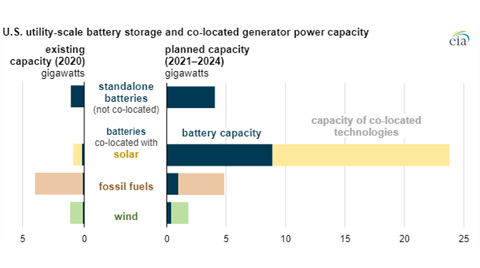Most planned battery storage to be paired with PV, EIA finds
29 September 2021
Another 1.3 GW of battery storage will be co-located at sites with wind turbines or fossil fuel-fired generators
Of the 14.5 GW of battery storage power capacity planned to come online in the United States from 2021 to 2024, 9.4 GW (63%) will be co-located with a solar photovoltaic (PV) power plant, according to the U.S. Energy Information Administration’s (IEA) Annual Electric Generator Report.
Another 1.3 GW of battery storage will be co-located at sites with wind turbines or fossil fuel-fired generators, such as natural gas-fired plants. The remaining 4.0 GW of planned battery storage will be located at standalone sites.

Historically, most U.S. battery systems have been located at standalone sites. Of the 1.5 GW of operating battery storage capacity in the United States at the end of 2020, 71% was standalone, and 29% was located onsite with other power generators, according to the EIA.
Most standalone battery energy storage sites have been planned or built in power markets that are governed by regional transmission organizations (RTOs) and independent system operators (ISOs). RTOs and ISOs can enforce standard market rules that lay out clear revenue streams for energy storage projects in their regions, which promotes the deployment of battery storage systems. Of the utility-scale battery systems announced to come online from 2021 to 2024, 97% of the standalone battery capacity and 60% of the co-located battery capacity are in RTO/ISO regions.
Over 90% of the planned battery storage capacity outside of RTO and ISO regions will be co-located with a solar PV plant. At some solar PV co-located plants, the batteries can charge directly from the onsite solar generator when electricity demand and prices are low. They can then discharge electricity to the grid when electricity demand is higher or when solar generation is unavailable, such as at night.
Although factors such as cloud cover can affect solar generation, solar generators in particular can effectively pair with battery storage because of their relatively regular daily generation patterns. This predictability works well with battery systems because battery systems are limited in how long they can discharge their power capacity before needing to recharge. If paired with a wind turbine, for example, a battery system could go days before having the opportunity to fully recharge.
STAY CONNECTED




Receive the information you need when you need it through our world-leading magazines, newsletters and daily briefings.
POWER SOURCING GUIDE
The trusted reference and buyer’s guide for 83 years
The original “desktop search engine,” guiding nearly 10,000 users in more than 90 countries it is the primary reference for specifications and details on all the components that go into engine systems.
Visit Now
CONNECT WITH THE TEAM










